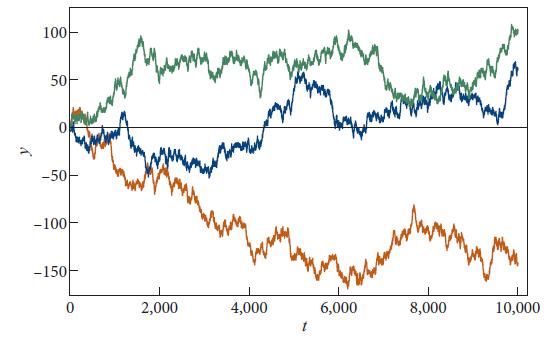(a) Explain why, physically, when the Brownian motion of a particle (which starts at x = 0...
Question:
(a) Explain why, physically, when the Brownian motion of a particle (which starts at x = 0 at time t = 0) is observed only on timescales △τ >> τr corresponding to frequencies f r , its position x(t)must be a Gaussian-Markov process with x̄ = 0.What are the spectral density of x(t) and its relaxation time in this case?
(b) Use Doob’s theorem to compute the conditional probability P2(x2, τ |x1). Your answer should agree with the result deduced in Ex. 6.3 from the diffusion equation, and in Ex. 6.4 from the central limit theorem for a random walk.
Data from Exercises 6.3
In Ex. 3.17, we studied the diffusion of particles through an infinite 3-dimensional medium. By solving the diffusion equation, we found that, if the particles’ number density at time t = 0 was no(x), then at time t it has become

where D is the diffusion coefficient [Eq. (3.73)].

For any one of the diffusing particles, the location y(t) in the y direction (one of three Cartesian directions) is a 1-dimensional random process. From the above n(x, t), infer that the conditional probability distribution for y is

Verify that the conditional probability (6.13) satisfies the Smoluchowski equation (6.11).

At first this may seem surprising, since a particle’s position y is not Markov. However, the diffusion equation from which we derived this P2 treats as negligibly small the timescale τr on which the velocity dy/dt thermalizes. It thereby wipes out all information about what the particle’s actual velocity is, making y effectively Markov, and forcing its P2 to satisfy the Smoluchowski equation.
Data from Exercises 6.4
A particle travels in 1 dimension, along the y axis, making a sequence of steps △yj (labeled by the integer j ), each of which is △yj = +1 with probability 1/2, or △yj = −1with probability 1/2.
After N >> 1 steps, the particle has reached location
![]()
What does the central limit theorem predict for the probability distribution of y(N)? What are its mean and its standard deviation?
Viewed on length scales >> 1, y(N) looks like a continuous random process, so we shall rename N ≡ t . Using the (pseudo)random number generator from your favorite computer software language, compute a few concrete realizations of y(t) for 0 4 and plot them.4 Figure 6.1 above shows one realization of this random process.
Explain why this random process is Markov.
Use the central limit theorem to infer that the conditional probability P2 for this random process is

Notice that this is the same probability distribution as we encountered in the diffusion exercise but with D = 1/2. Why did this have to be the case?
Using an extension of the computer program you wrote in part (b), evaluate y(t = 104) for 1,000 realizations of this random process, each with y(0) = 0, then bin the results in bins of width δy = 10, and plot the number of realizations y(104) that wind up in each bin. Repeat for 10,000 realizations. Compare your plots with the probability distribution (6.17).
Figure 6.1

Step by Step Answer:

Modern Classical Physics Optics Fluids Plasmas Elasticity Relativity And Statistical Physics
ISBN: 9780691159027
1st Edition
Authors: Kip S. Thorne, Roger D. Blandford




